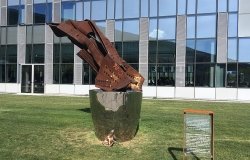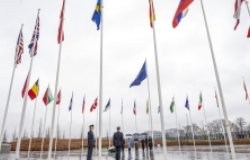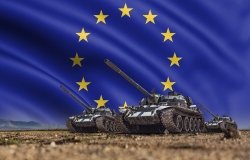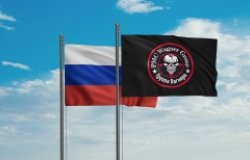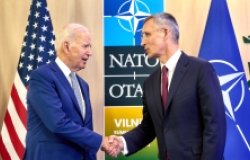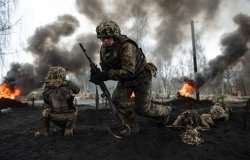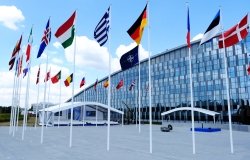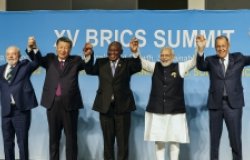354. A Litmus Test of the Century and its Social and Moral Order: Lithuania in the Twentieth Century
Leonidas Donskis is Professor of Political Science and Director of the School of Political Science and Diplomacy at Vytautas Magnus University in Kaunas, Lithuania. He spoke at an EES Noon Discussion on October 14, 2008. The following is a summary of his presentation. Meeting Report 354.
Lithuania cherishes historical memories of once belonging to a multi-ethnic, multi-religious and multi-cultural country. It also cherishes the most generous and noble-spirited traditions of the Romantic ethos of liberal nationalism, and quite justifiably so. In the late 1980s, Lithuania's national rebirth movement, Sajudis, and its "singing revolution" not only revived the spirit of the 19th Century epoch of the springtime of the peoples (whose slogan—For your and our freedom!—was raised as the banner), but also became a litmus test for the Soviet policies of glasnost (openness) and perestroika (reorganization). As the first republic to breakaway from the Soviet Union, Lithuania came to embody the historical triumph of East-Central Europe's time-honored struggle for freedom.
It was with good reason that the great Polish Romantic poet Adam Mickiewicz, who was born in Lithuania and who regarded it as his motherland, depicted Lithuania as a mysterious country, which disappears from history and then returns to it repeatedly. In 1990, Lithuania restored its independence after 50 years of political and cultural isolation. In 1918, Lithuania declared its independence after spending 123 years as part of Tsarist Russia. Each time, Lithuania came into existence through the revival of its historical memory and culture, rather than through an overt exercise of power. Culture led Lithuania from a political non-entity to a political presence. Its culture paved the way to politics, and not the other way around.
As a culture, Lithuania had long had at least two visions of how to fulfill itself as a modern historical actor. One of them, as mentioned, views Lithuania as a multi-ethnic, multi-religious and multi-cultural country deeply grounded in the political and cultural realities of the epoch of the Renaissance and Baroque. Another sees Lithuania as having its roots in Romanticism—the Lithuania of mystical influences, spirituality and organic community. Both visions and interpretations of Lithuanian culture are richly supported by historical evidence.
As a polity, Lithuania dates back to the early Middle Ages. It has an ancient language and an old culture both recalled and revived during the national rebirth movement in the 19th Century. One of the greatest powers in medieval Europe whose territory stretched from the Baltic Sea to the Black Sea, Lithuania eventually crumbled and lost its influence in modern Europe. Bearing in mind the fact that the country was part of Tsarist Russia from 1795 to 1918, that the Lithuanian elite adopted the Polish language and, finally, that Lithuania underwent considerable Russification in the 19th Century, the emergence of the Republic of Lithuania in 1918 was nothing short of miraculous. Yet, Lithuania enjoyed parliamentary democracy for just eight years: a coup in 1926 replaced the democracy with a mild authoritarian regime which lasted until 1940. Incidentally, this was the case in all three Baltic States. What happened in 1940 was a tragedy for the Baltic States, which were occupied and annexed by the Soviet Union.
To cut a long story short, Lithuanian cultural history reads like an exciting novel, if not an adventure story. Small wonder, then, that much of it has yet to be discovered by our fellow Europeans. The same applies to us—only now do Lithuanians appear to be capable of truly challenging themselves and offering new interpretations of their complex historical past. Having experienced the worst nightmares of both totalitarian ideologies and regimes during the Second World War, Lithuania was occupied by the Soviets in 1945, condemning the country to five decades of isolation from the Western world. Lithuania lost considerable groups from its society: hundreds of thousands of Lithuanian Jews perished in the Holocaust, the most educated and prosperous part of Lithuanian society was either exterminated or exiled to Siberia. Tens of thousands of Lithuanians fled to Germany after WWII. Having spent several years in displaced persons camps in West Germany, some of them moved to the U.S., Great Britain, Canada, and Australia, while others found shelter in continental Europe. As a result, many planes of Lithuanian identity have been developed over the past 70 years, especially among diverse émigré groups.
For instance, Aleksandras Shtromas, a major figure in the political science academic world, a Lithuanian-born British and American political scientist, a Lithuanian and Russian dissident, and an ardent patriot of Lithuania, regarded himself both as a Jew and a Lithuanian. In addition, he was a man who possessed a Russian sensitivity and who felt at home in Russian culture. Shtromas was a native bilingual, who spoke to his father in Lithuanian and to his mother in Russian. Leonid Pinsky, a noted Russian scholar of Renaissance literature and Shakespeare, and Grigory Pomerantz, an eminent Russian philosopher and scholar of Oriental cultures, made a great impact on Shtromas. As a Soviet dissident active in Lithuania and Russia, Shtromas knew in person and co-operated with such great Soviet dissidents as Andrei Sakharov, Elena Bonner, Andrei Sinyavsky, Yuli Daniel and Vladimir Bukovsky. Alexander Galich and Alexander Ginzburg were his close friends. Yet, his attachment to Lithuania and Russia did not prevent Shtromas from becoming an enthusiast of Great Britain and the United States, where he spent much of his time as an émigré scholar.
Another towering figure in Lithuanian academia and philosophy was Vasily Sesemann, who was born in Finland, and was the son of a Swedish-speaking Finnish father and of a Russian-speaking German mother. Sesemann was brought up in Russia and spent much time in Germany before moving to Lithuania in the 1920s and accepting a full professorship in philosophy at Vytautas Magnus University in Kaunas, Lithuania. Exiled to Siberia in 1945, Sesemann survived the Soviet camp and returned to occupied Lithuania, where he continued his research and gave lectures at Vilnius University. Influenced by German neo-Kantians of the Marburg School and phenomenology, Sesemann stood close to the Russian Formalists and may have laid the theoretical foundations for semiotics. Fluent in Lithuanian, Russian, German and Swedish, Vasily Sesemann (Wilhelm Sesemann in Finland and Vosylius Sezemanas in Lithuania) could be interchangeably described as a Finnish, Russian, German or Lithuanian philosopher. He, perhaps, merits the title of a great Baltic philosopher more than anyone else.
Throughout the 20th Century, Lithuania's self image as the Athens of the North has peacefully coexisted with a moderate messianic construct, casting this small nation as an important bridge between East and West (the former often reduced to Slavic civilization or Russia). The concept of a synthesis of civilizations—East and West—was elaborated and promoted by the Lithuanian philosopher Stasys Salkauskis, particularly in Sur les confins de deux mondes (On the Boundary of Two Worlds, 1919), a book on Lithuania written in French, in Switzerland. An examination of several inter-war Lithuanian philosophical texts reveals just how strongly Lithuanian philosophy was affected by 19th and 20th Century Russian philosophy. Two key Lithuanian intellectuals—Stasys Salkauskis and Vincas Mykolaitis-Putinas—wrote their doctoral dissertations at the University of Fribourg in Switzerland (both written in French), focusing on the prominent Russian religious philosopher Vladimir Soloviev.
Salkauskis studied Soloviev's philosophy of religion, while Putinas analyzed the Russian thinker's aesthetics. Salkauskis's dissertation was titled L'âme du monde dans la philosophie de Vl. Soloviev (Love of the World in the Philosophy of Vladimir Soloviev, 1920), Putinas's L'Esthétique de Vladimir Soloviev (Vladimir Soloviev's Aesthetics, 1923). During that period, in addition to Soloviev, other Russian writers and thinkers—Nikolai Berdyaev, Fyodor Dostoevsky, Konstantin Leontyev, the Russian nihilists, among others—influenced many Lithuanian academics and public intellectuals. In addition to other influences of Russian culture on Lithuania, these thinkers' ideas can, in part, be seen as a principal source of Lithuanian messianism. Roughly speaking, Salkauskis's vision of Lithuania as a bridge between the civilizations of East and West is nothing but another term for the specifically Russian notion of Eurasia, though this concept is usually reserved exclusively for Russia and its historic mission. A devout reader and follower of Soloviev, Salkauskis's concept of a synthesis of civilizations is merely a Lithuanian variation on a classic theme in 19th and 20th Century Russian social philosophy.
Eurasianism, both as a philosophical tendency and model of cultural or civilizational identity, was a central concept in Lev Karsavin's work and writing—he spent several decades lecturing in Lithuania, and fundamentally influenced the development of Lithuanian philosophy of culture and cultural history. In 1928, he was offered a professorship at Vytautas Magnus University in Kaunas, where he had arrived from Paris. An eminent Russian religious thinker and an erudite cultural historian, Karsavin soon became a fluent speaker of Lithuanian and established his reputation as one of the most brilliant lecturers at the University of Lithuania. A man with several planes of identity, and also of multidimensional spiritual and moral existence, Karsavin converted to Roman Catholicism. His five-volume magnum opus, Europos kulturos istorija (The Cultural History of Europe, 1931-1937), written in Lithuanian and published during the inter-war period, is a work of European significance and has yet to be surpassed by other Lithuanian contributions. When the Soviet Union occupied Lithuania after World War II, Karsavin was exiled to the Komi ASSR, where he died in 1952.
At the same time, Lithuania would be unthinkable without its magnificent Jewish legacy. Prior to World War II, Lithuania was famous for its very large Jewish community: about 240,000 Jews lived in Lithuania, yet only 20,000 survived the Holocaust. The Lithuanian capital, Vilnius (which had been occupied by Poland from 1920 to 1939), was known around the world as the Jerusalem of the North, and many internationally renowned Jews originated from or had lived in Lithuania. The history of Jewish civilization cannot be told without mentioning Lithuania's Jews—the Litvaks. Recall those who inscribed the names of the Litvaks and Lithuania on the cultural map of the 20th Century: the philosophers Emmanuel Lévinas and Aron Gurwitsch, the painters Chaïm Soutine (a close friend of Amedeo Modigliani in Paris), Pinkus Krémègne, Michel Kikoine, Marc Chagall, Neemija Arbitblatas, the sculptor Jacques Lipchitz, the violinist Jascha Heifetz and the art critic Bernard Berenson—all were Litvaks. How else can Berenson be described other than as a Lithuanian-born, Italian-British-American art critic; or Chagall as a Belarusian-born, Russian-French and deeply Jewish painter?
But then the question remains why and how is Chagall, born in Vitebsk, described as a Belarusian- or Russian-born French painter and why and how is Soutine, born in Smilovichi, characterized as a Lithuanian-born French painter? Both towns, Vitebsk and Smilovichi, throughout the 19th Century and in the beginning of the 20th, belonged to the Vilnius administrative area in Tsarist Russia. Moreover, both towns are historically related to what was once the Grand Duchy of Lithuania. Is not this difficulty to strictly define an artist with several planes of identity a symptom of the absurdity of the "one-language, one-nation, and one-culture" logic of mainstream nationalism? How can we "categorize" far and away the greatest ethicist of the 20th Century, Emmanuel Lévinas, other than as a Lithuanian-born French philosopher deeply rooted in both Russian and Jewish culture? Do any of them belong exclusively to the Litvak or Yiddish legacy? Should they not instead be identified as Europeans, who chose a country and a language of self-fulfillment? Do they tell a story about their culture, or is it the other way around?
Modern Lithuania has emerged as a characteristically East-Central European nation with an emphasis on a strong sense of history and on the critical role of culture and language in the process of political emancipation. Lithuania quite legitimately might be described as a nation of language, culture, and historical memory. Having been confined to a world of total control, severe censorship, violent politics, cynical lies, sinister ideological indoctrination, and brutal violation of basic human rights, Lithuania, like other nations of Central and Eastern Europe, knows the taste and value of freedom better than any Western European country. Torn away and isolated from the family of free nations for half a century, Lithuania finally made its return to where it belonged, namely, the Western world as a shared space of values.
Lithuania has thus reappeared in history as a small nation, whose political existence was bound to become, once again, a challenge to and an examination of the world order. The right to self-determination of nations, proclaimed and strongly advocated by Woodrow Wilson, has made Lithuania's emergence possible. Yet, becoming the first rebel and break-away republic in the former Soviet Union made it a litmus test for examining the modus vivendi between the Soviet Union and the West. The third fundamental change that took place recently, in which Lithuania and the other Baltic States and Central European countries became part of the Western security system, was a decisive event in world history, one that can profoundly influence this long-abandoned part of Europe.
About the Author
Leonidas Donskis

Global Europe Program
The Global Europe Program is focused on Europe’s capabilities, and how it engages on critical global issues. We investigate European approaches to critical global issues. We examine Europe’s relations with Russia and Eurasia, China and the Indo-Pacific, the Middle East and Africa. Our initiatives include “Ukraine in Europe” – an examination of what it will take to make Ukraine’s European future a reality. But we also examine the role of NATO, the European Union and the OSCE, Europe’s energy security, transatlantic trade disputes, and challenges to democracy. The Global Europe Program’s staff, scholars-in-residence, and Global Fellows participate in seminars, policy study groups, and international conferences to provide analytical recommendations to policy makers and the media. Read more
